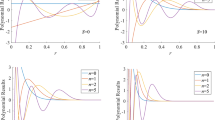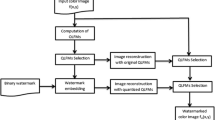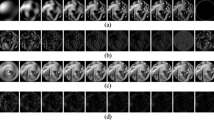Abstract
As a copyright protection technology, zero-watermarking has received widespread attention in recent years. The zero-watermarking algorithm based on moments has been extensively studied due to its better comprehensive performance and has made great progress. However, three issues of the moments-based zero-watermarking methods should be addressed: first, most of them ignore the analysis and experiment on discriminability, which leads to the high false positive ratio; second, direct computation of the moments from their definition is inefficient, numerically unstable and inaccurate, which severely affects the performances of these moments-based methods; third, most of the algorithms are only suitable for grayscale images, which leads to the limitation of the algorithms in practical applications. In this paper, we present a new color image zero-watermarking using fast quaternion log-polar radial harmonic Fourier moments. This algorithm firstly introduces log-polar coordinates to make traditional RHFMs scale-invariant, secondly improves their speed and accuracy, then introduces the concept of quaternion to make it suitable for color images, and finally applies it to the zero-watermark technology. Theoretical analysis and experimental results show that compared to the existing algorithms, the BER value of the proposed algorithm is 0 under some attacks, which can prove its effectiveness and achieved a good trade-off between discriminability and robustness, and has certain superiority in terms of security, capacity and speed.




















Similar content being viewed by others
References
Hurrah, N.N., Parah, S.A., Loan, N.A., Sheikh, J.A., Elhoseny, M., Muhammad, K.: Dual watermarking framework for privacy protection and content authentication of multimedia. Future Gener. Comput. Syst. 94, 654–673 (2019)
Wen, Q., Sun, T.F., Wang, S.X.: Concept and application of zero-watermark. Acta Electron. Sin. 31(2), 214–216 (2003)
Yu, X., Wang, C., Zhou, X.: A hybrid transforms-based robust video zero-watermarking algorithm for resisting high efficiency video coding compression. IEEE Access 7, 115708–115724 (2019)
Sun, L., Xu, J.C., Zhang, X.X.: A novel generalized Arnold transform-based zero-watermarking scheme. Appl. Math. Inf. Sci. 4, 2023–2035 (2015)
Liu, X., Wang, Y., Sun, Z., Wang, L., Zhao, R., Zhu, Y., Zou, B.: Robust and discriminative zero-watermark scheme based on invariant features and similarity-based retrieval to protect large-scale DIBR 3D videos. Inf. Sci. 542, 263–285 (2021)
Chen, B.J., Shu, H.Z., Zhang, H., Chen, G., Toumoulin, C., Dillenseger, J.L.: Quaternion zernike moments and their invariants for color image analysis and object recognition. Signal Process. 92(2), 308–318 (2012)
Thanh, T.M., Tanaka, K.: An image zero-watermarking algorithm based on the encryption of visual map feature with watermark information. Multimed. Tools Appl. 76(11), 13455–13471 (2017)
Fan, T.Y., Chao, H.C., Chieu, C.C.: Lossless medical image watermarking method based on significant difference of cellular automata transform coefficient. Signal Process. Image Commun. 70, 174–183 (2019)
Ali, M., Ahn, C.W., Pant, M.: An efficient lossless robust watermarking scheme by integrating redistributed invariant wavelet and fractional Fourier transforms. Multimed. Tools Appl. 77(10), 11751–11773 (2018)
Teague, M.R.: Image analysis via the general theory of moments. J. Opt. Soc. Am. 70(8), 920–930 (1980)
Xin, Y., Pawlak, M., Liao, S.: Accurate computation of Zernike moments in polar coordinates. IEEE Trans. Image Process. 16, 581 (2007)
Chen, B., Shu, H., Zhang, H., Coatrieux, G., Luo, L., Coatrieux, J.L.: Combined invariants to similarity transformation and to blur using orthogonal Zernike moments. IEEE Trans. Image Process. 20(2), 345–360 (2011)
Singh, C., Mittal, N., Walia, E.: Complementary feature sets for optimal face recognition. EURASIP J. Image Video Process. 1, 1–18 (2014)
Guo, Y., Liu, C.P., Gong, S.R.: Improved algorithm for Zernike moments. In: International Conference on Control, Automation and Information Sciences (ICCAIS), pp. 307–312 (2015)
Bera, A., Klęsk, P., Sychel, D.: Constant-time calculation of Zernike moments for detection with rotational invariance. IEEE Trans. Pattern Anal. Mach. Intell. 41(3), 537–551 (2018)
Ping, Z., Ren, H., Zou, J., Sheng, Y., Bo, W.: Generic orthogonal moments: Jacobi-Fourier moments for invariant image description. Pattern Recognit. 40(4), 1245–1254 (2007)
Hoang, T.V., Tabbone, S.: Errata and comments on “Generic orthogonal moments: Jacobi-Fourier moments for invariant image description.” Pattern Recognit. 46(11), 3148–3155 (2013)
Camacho-Bello, C., Toxqui-Quitl, C., Padilla-Vivanco, A., Báez-Rojas, J.J.: High-precision and fast computation of Jacobi-Fourier moments for image description. JOSA A 31(1), 124–134 (2014)
Upneja, R., Singh, C.: Fast computation of Jacobi-Fourier moments for invariant image recognition. Pattern Recognit. 48(5), 1836–1843 (2015)
Yap, P.T., Paramesran, R., Ong, S.H.: Image analysis using Hahn moments. IEEE Trans. Pattern Anal. Mach. Intell. 29(11), 2057–2062 (2007)
Xiao, B., Ma, J., Wang, X.: Image analysis by Bessel-Fourier moments. Pattern Recognit. 43(8), 2620–2629 (2010)
Yap, P.T., Jiang, X., Kot, A.C.: Two-dimensional polar harmonic transforms for invariant image representation. IEEE Trans. Pattern Anal. Mach. Intell. 32(7), 1259–1270 (2009)
Singh, C., Upneja, R.: Accuracy and numerical stability of high-order polar harmonic transforms. IET Image Proc. 6(6), 617–626 (2012)
Hosny, K.M., Darwish, M.M.: A Kernel-Based method for fast and accurate computation of PHT in polar coordinates. J. Real-Time Image Proc. 16(4), 1235–1247 (2019)
Qi, M., Li, B.Z., Sun, H.: Image representation by harmonic transforms with parameters in SL (2, R). J. Vis. Commun. Image Represent. 35, 184–192 (2016)
Upneja, R., Pawlak, M., Sahan, A.M.: An accurate approach for the computation of polar harmonic transforms. Optik 158, 623–633 (2018)
Liu, X., Wu, Y., Shao, Z., Wu, J.: The modified generic polar harmonic transforms for image representation. Pattern Anal. Appl. 23(2), 785–795 (2020)
Kang, X., Zhao, F., Chen, Y., Lin, G., Jing, C.: Combining polar harmonic transforms and 2D compound chaotic map for distinguishable and robust color image zero-watermarking algorithm. J. Vis. Commun. Image Represent. 70, 102804 (2020)
Gao, G., Jiang, G.: Bessel-Fourier moment-based robust image zero-watermarking. Multimed. Tools Appl. 74(3), 841–858 (2015)
Shao, Z., Shang, Y., Zeng, R., Shu, H., Coatrieux, G.: Robust watermarking scheme for color image based on quaternion-type moment invariants and visual cryptography. Signal Process. Image Commun. 48, 12–21 (2016)
Wang, C.P., Wang, X.Y., Xia, Z.Q., Zhang, C.: Geometrically resilient color image zero-watermarking algorithm based on quaternion Exponents. J. Vis. Commun. Image Represent. 41, 247–259 (2016)
Wang, C., Wang, X., Xia, Z., Zhang, C.: Ternary radial harmonic Fourier moments based robust stereo image zero-watermarking algorithm. Inf. Sci. 470, 109–120 (2019)
Xia, Z.Q., Wang, X.Y., Zhou, W.J.: Color medical image lossless watermarking using chaotic system and accurate quaternion polar harmonic transforms. Signal Process. 157, 108–118 (2019)
Xia, Z., Wang, X., Wang, M., Unar, S., Wang, C., Liu, Y., Li, X.: Geometrically invariant color medical image null-watermarking based on precise quaternion polar harmonic Fourier moments. IEEE Access 7, 122544–122560 (2019)
H. Y. Yang, S. R. Qi, P. P. Niu, X. Y. Wang. Color image zero-watermarking based on fast quaternion generic polar complex exponential transform. Signal Processing: Image Communication, 2020, 82:115747.
Ren, H., Ping, Z., Bo, W., Wu, W.: Multidistortion-invariant image recognition with radial harmonic Fourier moments. J. Opt. Soc. Am. A 20(4), 631–637 (2003)
Averbuch, A., Coifman, R.R., Donoho, D.L.: Fast and accurate polar Fourier transform. Appl. Comput. Harmon. Anal. 21(2), 145–167 (2006)
Wang, C., Wang, X., Li, Y., Xia, Z., Zhang, C.: Quaternion polar harmonic Fourier moments for color images. Inf. Sci. 450, 141–156 (2018)
Li, Y.N.: Quaternion polar harmonic transforms for color images. IEEE Signal Process. Lett. 20(8), 803–806 (2013)
Hamilton, W.R.: Elements of Quaternions. Longmans Green, London (1866)
Wang, C.P., Wang, X.Y., Xia, Z.Q.: Geometrically invariant image watermarking based on fast radial harmonic Fourier moments. Signal Process. Image Commun. 45, 10–23 (2016)
Hosny, K.M., Darwish, M.M.: Resilient color image watermarking using accurate quaternion radial substituted chebyshev moments. ACM Trans. Multimed. Comput. Commun. 15, 24727–24750 (2019)
Yang, H.Y., Wang, X.Y., Wang, P.: Geometrically resilient digital watermarking scheme based on radial harmonic Fourier moments magnitude. AEU Int. J. Electron. Commun. 69(1), 389–399 (2015)
Teh, C.H., Chin, R.T.: On image analysis by the methods of moments. IEEE Trans. Pattern Anal. Mach. Intelli. 10(4), 496–513 (1988)
Yap, P.T., Jiang, X., Kot, A.C.: Two-dimensional polar harmonic transforms for invariant image representation. IEEE Trans. Pattern Anal. Mach. Intell. 32(7), 1259–1270 (2010)
Zhu, H., Yang, Y., Gui, Z., Zhu, Y., Chen, Z.: Image analysis by generalized Chebyshev-Fourier and generalized pseudo-Jacobi-Fourier moments. Pattern Recognit. 51, 1–11 (2016)
Xiao, B., Wang, G., Li, W.: Radial shifted Legendre moments for image analysis and invariant image recognition. Image Vis. Comput. 32, 994–1006 (2014)
Guo, F., Ye, S., Yang, T., Wang, X.: Robust circularly orthogonal moment based on Chebyshev rational function. Digital. Signal Process. 62, 249–258 (2017)
Wang, X.Y., Li, W.Y., Yang, H.Y., Niu, P.P., Li, Y.W.: Invariant quaternion radial harmonic Fourier moments for color image retrieval. Opt. Laser Technol. 66, 78–88 (2015)
Hu, H., Zhang, Y., Shao, C.: Orthogonal moments based on exponent functions: exponent-Fourier moments. Pattern Recognit. 47(8), 2596–2606 (2014)
J. C. Lagarias, H. A. Porta, K. B. Stolarsky. Asymmetric tent map expansions. I. Eventually periodic points, J. Lond. Math. Soc.-Second Ser, 1993, 2(3): 542–556.
Johnson, K.A., Becker, J.A.: The Whole Brain Atlas. http://www.med.harvard.edu/AANLIB/home.html
Parah, S.A., Sheikh, J.A., Ahad, F.: Information hiding in medical images: a robust medical image watermarking system for E-healthcare. Multimed. Tools Appl. 76(8), 10599–10633 (2017)
Kalker, T., Haitsma, J., Oostveen, J.C.: Issues with digital watermarking and perceptual hashing. In: Proceedings of SPIE 4518, Multimedia Systems and Applications, Denver, Co, USA, pp 189–197 (2001)
Acknowledgements
This work was supported partially by the National Natural Science Foundation of China (Nos. 61472171 and 61701212), Scientific Research Project of Liaoning Provincial Education Department (No. LJKZ0985), and Natural Science Foundation of Liaoning Province (2019-ZD-0468).
Author information
Authors and Affiliations
Corresponding authors
Ethics declarations
Conflict of interest
The authors declare that they have no conflict of interest.
Ethical Standard
All procedures performed in studies involving human participants were in accordance with the ethical standards of the institutional and/or national research committee and with the 1964 Helsinki Declaration and its later amendments or comparable ethical standards.
Informed Consent
Informed consent was obtained from all individual participants included in the study.
Additional information
Publisher's Note
Springer Nature remains neutral with regard to jurisdictional claims in published maps and institutional affiliations.
Appendices
Appendix A
Take the absolute value of both sides of this equation, we have
And, consequently
Appendix B
Take N as an example when N is even
To achieve discretization, the radius \(r\) and angle \(\theta\) are divided into \(M\) parts, and then
The discrete form of RHFM is
According to the 2D-DFT
where
From this we can obtain
When N is 0 and when N is odd, the proof is similar to the above.
Appendix C
The sampling point PP is substituted into the formula of 2D discrete RHFMs, we can obtain,
I'm going to deform the above equation
According to the above formula, when N is even, the RHFMs are obtained by adding the Fourier transform of two very similar forms, so let
So let's think about the sum inside
It can be seen that \(\phi_{1}^{BV}\) is the one-dimensional Fourier transform of \(f\) in the direction of \(i_{2}\). In order to adjust the range of variable \(q\), we carry out zero filling of \(f\) in the direction of \(i_{2}\)
Here
Set \(q^{\prime} = q + N\), we're going to get
Now let's think about the sum on the outside
Set \(\alpha = \frac{p}{N}\), we can obtain
From the identity relation \({2}i_{1} q = q^{2} + i_{1}^{2} - (q - i_{1} )^{2}\), we can get by deforming the above equation
So if \(s[i_{1} ] = e^{{ - \frac{j\pi \alpha }{N}i_{1}^{2} }}\), \(\phi_{1}^{BV} [p,q]\) can be represented as
Thus, the complete formula of RHFMs when N is even can be obtained as follows:
Here, \(s_{1} [i_{1} ] = \exp \left( { - \frac{j\pi \alpha }{N} \cdot i_{1}^{2} } \right)\), \(s_{2} [i_{1} ] = \exp \left( {\frac{j\pi \alpha }{N} \cdot i_{1}^{2} } \right)\).
Appendix D
Take \(n\) as an example when \(n\) is even:
Thus, we can obtain
Therefore, we can say that the quaternion log-polar RHFMs have rotation and scaling invariance.
In the same way, we can obtain the \(\left| {\phi_{n,m}^{R} } \right| = \left| {\phi_{n,m}^{R} } \right|.\)
Appendix E
To calculate the quaternion RHFMs in log-polar domain, it’s necessary to determine the relationship between the log-polar RHFMs and quaternion log-polar RHFMs. After determining the relationship, it’s easy to obtain FQLPRHFMs according to the FLPRHFMs. The proof process is as follows
Rights and permissions
About this article
Cite this article
Niu, PP., Wang, L., Wang, F. et al. Fast Quaternion Log-Polar Radial Harmonic Fourier Moments for Color Image Zero-Watermarking. J Math Imaging Vis 64, 537–568 (2022). https://doi.org/10.1007/s10851-022-01084-0
Received:
Accepted:
Published:
Issue Date:
DOI: https://doi.org/10.1007/s10851-022-01084-0




